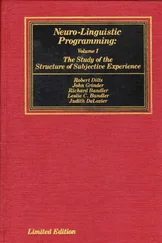Usually thinking of the smell and taste will take the person right back to the alcoholic state. Olfactory access is probably the fastest way to regress. Any time you want someone to re–experience some past state, if you can find an odor associated with that state, just having the person smell that smell will immediately take him back to that past state in all systems. Because of the way smells are processed neurologically, they have a much more direct impact on behavior and responses than other sensory inputs do.
Man: You called this method a hypnotic induction. Are you saying that any time you ask someone to go back, you've induced a hypnotic state or begun an induction?
There might be a question of semantics here about whether you want to call it hypnosis or not. I wouldn't call it that overtly; that might elicit resistance from the client. But, in my perceptions, what I've just described is indistinguishable from an «official» trance induction. The depth may vary a bit, but the actual procedure and the internal strategies a person employs are identical. So one way to get access would be this kind of an induction. What's another way to access the alcoholic part?
Man: Overlap. Have him see himself drunk, and then fit himself into his body in the picture.
OK. What's another way to get access to the alcoholic part? You should have half a dozen choices.
Man: Give him a drink.
Then you would have the problem of getting access to the sober part. Man: Take him to a bar.
Yes. That's using context as an anchor to elicit the state.
Another way you can do it is to pace and lead your client into a drunken state. Mirror your client and then begin to talk, walk, and act like a drunk yourself.
Another possibility is to give him direct instructions. «I want you to pretend to be drunk.» He'll probably say «But that's what I'm trying to avoid!» Then you say «Yes, I understand that, and in order to avoid it, you first need to have the choice of pretending.» There's no actual logic to that statement, but it sounds meaningful, and will get your client to do it.
Once he's begun to pretend, you can increase the quality of the access with feedback. «Ah, come on. Slur your speech a little more. Let's have a little more body sway—a little more tremor here. Are your eyes really blurred yet?» Give him verbal and behavioral feedback to adjust his behavior until you have a good access to his alcoholic part.
It's important to have a variety of ways to get access when you are dealing with people who have severely dissociated sequential incongruities. If you're not satisfied with the access you get using one maneuver, you can always shift to another.
Once you have access, anchor it so that you can get it back. When you have a good anchor for both his sober part and his alcoholic part, then you are ready to «blow his brains out," technically speaking. You collapse anchors for those two states by firing both anchors simultaneously, making both of those states occur at the same time. I generally use kinesthetic anchors for this, because he cannot get away from my touch.
The visible results of collapsing anchors on two states as different as sober and drunk states are remarkable. It definitely induces an altered state. I've seen a client reeling in states of semi–consciousness or unconsciousness for anywhere from three minutes up to an hour and a half. You will see what looks like total confusion; he will literally be unable to organize any coherent response. Sometimes his body movements are out of control, and he has whole–body convulsions. I've actually had a client go into a psychotic break and attempt to do anything he could to get my hands off him, because he knows that his experience is connected with my touch.
What's going on is that I'm jamming together two physiological states that were absolutely dissociated. He has never had those feelings simultaneously in his body. He has never tried to breathe the drunk way and the sober way at the same time, or had the muscle tone or the internal states of consciousness associated with those two states at the same time. In a sense, he was a multiple personality, and you are slamming those two parts together. This really is a sort of shock treatment, and some people have even spontaneously described it that way. The difference is that it's not externally induced, and it will only attain intensities that people can cope with. It's ecological in that sense.
When you have finished collapsing those two anchors, the integration is in no way complete. It simply allows you to have a bridge, so that the alcoholic and the sober person co–exist in the same body at the same time. The two parts are no longer mutually exclusive and completely dissociated. That makes it possible for you to do reframing. This is a precondition for establishing an effective channel of communication through the sober part to the alcoholic part which knows about the drinking problem and what needs it satisfies.
Woman: What do you do while you hold the two anchors and the person is confused for an hour and a half?
I only have to hold the two anchors until the integration is well underway. Then I just make sure he is in a place where he won't hurt himself; that's about all that's necessary. It's also useful to introduce lots of post–hypnotic suggestions while he is in this state of confusion. He will be utterly defenseless at that point. Make sure that your post–hypnotic suggestions are content–free so that you don't impose. You might say «As you continue to thrash around, notice that there's a direct relationship between how intense the feelings are now and how rapidly you'll gain the behavioral choices you want with respect to drinking.»
Since he can't defend against suggestions at that point, you have a tremendous responsibility for the way you frame the suggestions. «You will no longer want to drink» would be the most disastrous way of approaching it. It would be better to keep your mouth shut than to say something like that. You need to talk in positive terms about what will happen in the future, rather than what won't. «You will be able to find alternative ways to satisfy yourself in the way that alcohol used to» is much better. When you talk about the alcohol, you need to speak in the past tense, presupposing that he will no longer use it. All of the hypnotic language patterns described in Patterns I and Trance–formations are appropriate here. If he says «But I don't understand you," you can respond «Of course you don't understand me, and the less you understand me consciously, the more you will be able to reorganize unconsciously in positive ways.»
Man: When you collapse anchors for being drunk and being sober, don't you run the risk of making the person act drunk all the time?
That is a reasonable concern. Giving hypnotic process instructions such as those I've been describing is a way to make sure that the integration you get from collapsing anchors is useful. You say things about how those two states can begin to blend in such a way that the person incorporates all that is useful and valuable in each state, losing nothing, so that the integration can serve as the foundation for more choice, etc.
Let me remind you that this is only a preliminary step. I'm deliberately breaking down barriers between two dissociated states and inducing confusion. I'm literally violating a discrimination, an internal sorting process, that the alcoholic has unconsciously used to make himself effective in life. After doing this, I'm going to have to clean it up with reframing. All I've done is create the precondition for reframing. I now have access to the drunk part and the sober part at the same time. I have reduced a very difficult situation of sequential incongruity to something I can cope with: simultaneous incongruity.
Читать дальше











